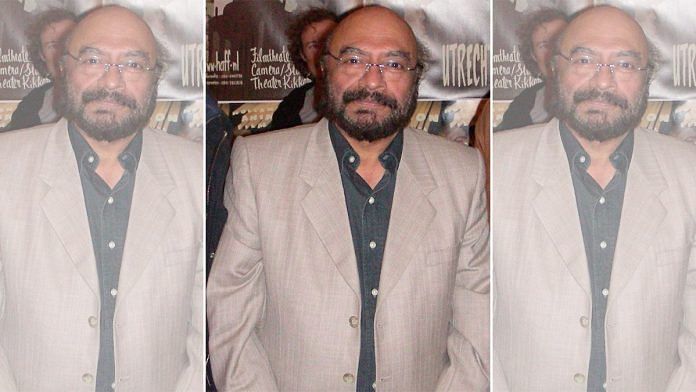New Delhi: Filmmaker Sudhir Mishra took to Twitter Sunday to question why movie buffs had forgotten one of the pillars of Indian parallel cinema, Govind Nihalani. Mishra said Nihalani, who turned 80 Saturday, was “barely remembered” these days, despite making classics like Aakrosh, Ardh Satya, Party and Drohkaal.
Weird isn't it . The guy who made Aakrosh , Ardhasatya , Party and Drohkaal and many others , including Vijeta is barely remembered ! Guess why ? https://t.co/LZjTgPDjKK
— Sudhir Mishra (@IAmSudhirMishra) December 20, 2020
Nihalani had made his directorial debut with a bang in 1980, as his Aakrosh, starring Naseeruddin Shah, Om Puri and Amrish Puri, went on to win the National Film Award for Best Feature Film in Hindi, numerous Filmfare Awards, as well as the ‘Golden Peacock’ for best film at the International Film Festival of India.
Aakrosh and his following work earned Nihalani the image of a filmmaker who highlighted the dark and real depictions of human angst. But despite being a proponent of ‘art’ cinema, Nihalani also once said in an interview: “I am fully aware that if a film does not recover its cost it would be difficult for a director to make his next film.”
Nihalani’s last Hindi film as director was Dev, released in 2004. But his career isn’t over — Nihalani directed a Marathi movie called Ti Ani Itar released in 2019, and also has a 3D animation movie called Up Up and Up in the pipeline.
Also read: Aakrosh, Om Puri’s masterclass in the art of silence, is especially powerful after Hathras
Indelible imprint of Partition on his work
Born in 1940 to a Sindhi family in Karachi, Nihalani was only seven at the time of Partition, and even saw a man being stabbed in the back — as he stood on the terrace of his house — before moving to India from what is now Pakistan. This visual influenced his memorable television series Tamas, which was based on writer Bhisham Sahni’s eponymous Partition novel.
The opening visual of Tamas, in fact, noted, “Those who forget history, find themselves condemned to repeat it.”
As the Partition riots broke out, Nihalani and his family fled to Jodhpur, eventually settling in Udaipur. As an 18-year-old, Nihalani told his father he wanted to work in films, and, after an initial shock, he was allowed to pursue his dreams on advice from the family’s guru.
He then completed a three-year course in cinematography at Sri Jayachamarajendra Occupational Institute in what was then Bangalore. According to Nihalani, by the end of the programme, thanks to the diverse courses, he “finished the course as a filmmaker”.
Nihalani came to Mumbai in 1962, but it was only in 1971 that he first worked with the legendary filmmaker Shyam Benegal, whom he referred to as his mentor.
Nihalani worked on ad films with Benegal, and then went on to be the cinematographer for eight of the latter’s movies, including Manthan, Nishant, Bhumika and Junoon. He said in an interview that he learnt the nuances of filmmaking from Benegal.
After branching off on his own with Aakrosh, Nihalani himself became an institution of parallel cinema, with films such as Vijeta (1982), Ardh Satya (1983), Party (1984), the series Tamas (1987), Drohkaal (1994) and Hazaar Chaurasi Ki Maa (1997).
Growing bitterness
Nihalani once remarked about his cinematic style: “They wanted stars and chocolate heroes, we didn’t…they wanted songs and dance, we didn’t.”
In a discussion with documentary filmmaker Rakesh Sharma, he had even bemoaned: “Our 1970s movement was supported by government funds and the media. Now the media is totally seduced by glitz.”
On how the parallel cinema movement could continue to grow, Nihalani said: “Go to spaces not controlled by the state; don’t look for state sponsorship.”
He called his last Hindi feature film, Dev, an extension of Ardh Satya. However, he had been angry about cuts ordered by censors in the film, saying: “The censors cleared Tamas without a single cut. In Dev, I was asked to delete words like Gujarat and Ayodhya. Shows how intolerance has grown.”
Also read: Om Puri and Smita Patil’s Ardh Satya is the only police drama you need to watch



